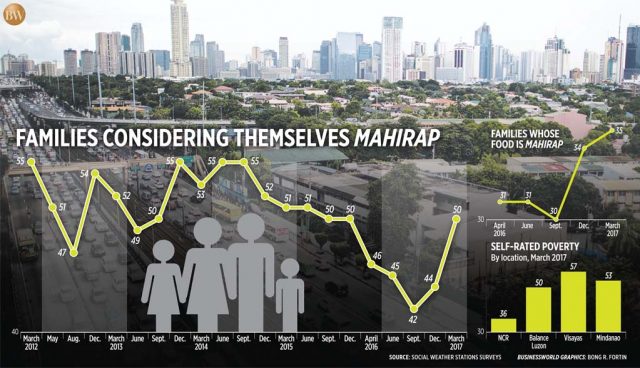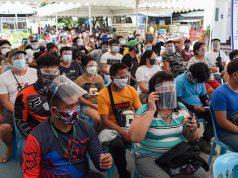MANILA – According to the Social Weather Station 2017 First Quarter survey, 50 percent of the respondents rating themselves “poor” with all geographical areas seeing slight increments.
The survey, conducted on March 25-28 via face-to-face interviews with 1,200 adults nationwide and with sampling error margins of ±3 points for national percentages and ±6% each for Metro Manila, Balance Luzon, the Visayas and Mindanao, found 50% of respondents, or, extrapolated statistically, “an estimated 11.5 million families considering themselves mahirap, or poor.”
This result is six points more than 44% or an estimated 10 million recorded in December 2016.
See the report in BusinessWorld
The SWS noted that “prior to this rise,” the self-rated poverty reading “had been either steady or declining for nine consecutive quarters from the fourth quarter of 2014 to the fourth quarter of 2016.”
The latest survey also found 35% (8.1 million families) rating their food as poor, termed by SWS as “food-poor.” This is a point more than the 34% (7.7 million families) in December 2016.
The survey bared that median poverty threshold – referring to the monthly home expense budget “that would satisfy the poorer half of poor households” – is P20,000 in Metro Manila and P10,000 each in Balance Luzon, the Visayas, and Mindanao.
“Self-rated food-poverty had been either steady or declining from the third quarter of 2015 to the third quarter of 2016,” the SWS likewise noted.
Among geographical areas, self-rated poverty rose the most in Balance Luzon: by eight points to 50% last quarter from 42% in December 2016.
Mindanao saw the second-biggest increase of six points to 53%, Metro Manila saw a five-point rise to 36%, while in the Visayas the reading edged up a point to 57%.
Meanwhile, SWS attributed the one point increment in self-rated food poverty rate in the first quarter to the nine-point increase in Balance Luzon to 41% that was offset by decreases of 10 points in the Visayas to 33%, three points in Metro Manila to 20% and two points in Mindanao to 35%.
The same survey also bared that median poverty threshold – referring to the monthly home expense budget “that would satisfy the poorer half of poor households” – is P20,000 in Metro Manila and P10,000 each in Balance Luzon, the Visayas, and Mindanao.
“The minimum home budget is less than the minimum income that a poor family needs because it excludes work-related expenses, such as transportation,” SWS said, noting that the latest amounts for Metro Manila and Mindanao “are the highest levels reached in those areas” although they had been reached in a number of previous surveys.
The same poll likewise reported that median food poverty threshold – the monthly food budget that would satisfy the poorer half of the food-poor households – is P9,000 in Metro Manila and P5,000 each in Balance Luzon, the Visayas and Mindanao.
“The March 2017 median self-rated food poverty thresholds in the Visayas and Mindanao are at the highest levels ever reached in those areas,” SWS said, even as the amounts had been reached in previous surveys.
Pulling more Filipinos out of poverty remains the ultimate goal of the current administration’s economic programs.
Sought for comment, Presidential Spokesperson Ernesto C. Abella said in a mobile phone message that the survey results indicate that the government “needs to intensify its response to poverty felt by many and to heighten their awareness of the ongoing programs and projects.”
“While circumstances are quickly improving, people need to know what is available out there.”
For National Anti-Poverty Commission (NAPC) head Liza Maza, the increase in self-rated poverty shows the need for a “multidimensional approach to poverty reduction that NAPC has been advocating.”
“We may be neglecting to address certain deprivations, such as shelter or security of jobs and livelihoods, that constitute what makes people feel they are poor,” Ms. Maza said in a mobile phone message.
“This increase shows that we still have a lot of work ahead of us.”










